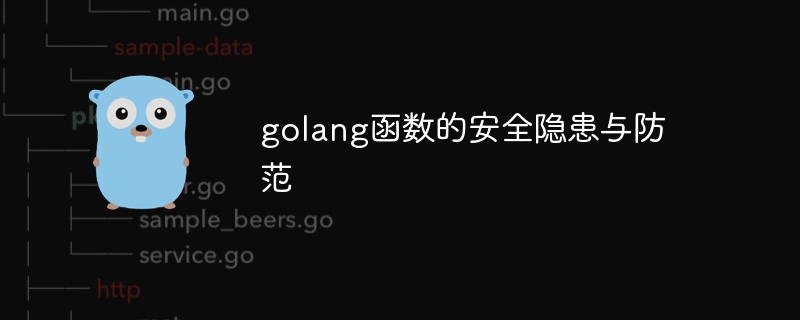
In Go programming, functions have the following security risks: variable parameters lead to buffer overflow, insufficient input validation leads to malicious code injection, and cross-boundary calls lead to type conversion errors. Precautions include limiting parameter variability, performing comprehensive input validation, using safe functions, and limiting cross-boundary calls. Practical cases demonstrate the security risks of cross-boundary calls, showing that attackers can disrupt program behavior by controlling request parameters.

Security hazards and prevention of Go functions
In Go programming, functions are the basic elements of the code. However, there are some security risks when using functions that can lead to unpredictable behavior or even security vulnerabilities. This article will explore these pitfalls and provide preventive measures.
Security hazard
1. Variable parameters
Variable parameters in the Go function may cause buffer overflow or other security issues. If a function has a variable number of parameters and an attacker is able to control the parameter values, it is possible for them to create malformed inputs that could overflow the function's internal buffer.
2. Insufficient input validation
If input is not sufficiently validated, an attacker may be able to corrupt the behavior of a function by injecting malicious code or data. For example, a function can accept user input and store it in a string, and if the input is not properly validated, an attacker can inject code execution or disrupt the program's execution flow.
3. Cross-border calls
When functions are called between different packages or modules, they may cause cross-border calls. If cross-boundary calls are unsafe, they may result in type conversion errors, access violations, or other security issues.
Precautions
1. Limit parameter variability
If possible, avoid using variable parameters. If you must use variadic arguments, you must carefully validate the input and ensure sufficient capacity of the buffer.
2. Perform comprehensive input validation
Strict input validation must be used in functions that accept user input. Validation should include checking the type, format, and range of the input.
3. Use safe functions
Go provides many built-in safe functions that can help prevent common security vulnerabilities. For example, strconv.ParseInt can be used to safely convert a string to an integer, while filepath.Clean can be used to safely handle file paths.
4. Restrict cross-boundary calls
If cross-boundary calls must be made, measures need to be taken at the call point and target function to ensure the security of the call. You can use type checking, interface checking, or access control to ensure that only functions are called safely.
Practical Case
The following is a practical case that demonstrates the security risks of cross-border calls:
package main
import (
"fmt"
"log"
"net/http"
)
type User struct {
ID int
Name string
}
// externalPackage 函数定义在一个外部包中
func externalPackage(u User) {
fmt.Println(u.ID)
}
func main() {
// 假设攻击者控制了请求
r := http.Request{}
r.Form["id"] = []string{"100"}
// 根据请求创建 User 对象
u := User{ID: 10}
err := r.ParseForm()
if err != nil {
log.Fatalf("无法解析表单: %v", err)
}
// 将 User 对象作为参数传递给 externalPackage
externalPackage(u)
}In this example, the attacker can Pass any value to the externalPackage function by controlling the id parameter of http.Request. If the externalPackage function does not properly validate input types, an attacker could break the behavior of the program.
Conclusion
By understanding the security risks of Go functions and taking appropriate precautions, we can reduce the risk of security vulnerabilities and ensure the security of our applications.
The above is the detailed content of Security risks and prevention of golang functions. For more information, please follow other related articles on the PHP Chinese website!
 How to define variables in golang
How to define variables in golang
 What are the data conversion methods in golang?
What are the data conversion methods in golang?
 What are the commonly used libraries in golang?
What are the commonly used libraries in golang?
 What is the difference between golang and python
What is the difference between golang and python
 Laravel Tutorial
Laravel Tutorial
 How to solve the problem that teamviewer cannot connect
How to solve the problem that teamviewer cannot connect
 clonenode usage
clonenode usage
 How to check deleted call records
How to check deleted call records




